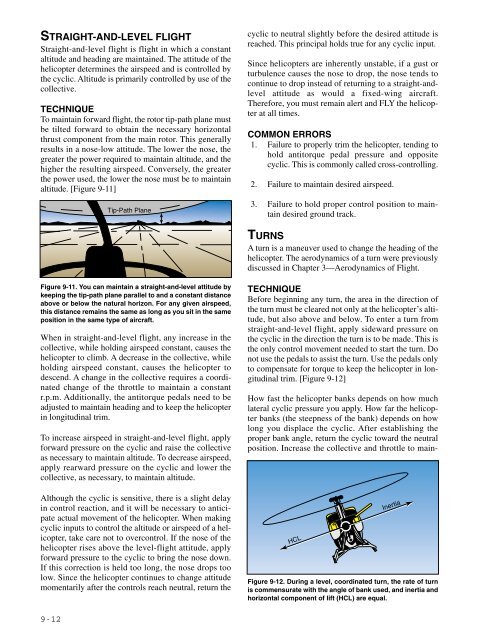Rotorcraft Flying Handbook, FAA-H-8083-21
Rotorcraft Flying Handbook, FAA-H-8083-21
Rotorcraft Flying Handbook, FAA-H-8083-21
You also want an ePaper? Increase the reach of your titles
YUMPU automatically turns print PDFs into web optimized ePapers that Google loves.
STRAIGHT-AND-LEVEL FLIGHT<br />
Straight-and-level flight is flight in which a constant<br />
altitude and heading are maintained. The attitude of the<br />
helicopter determines the airspeed and is controlled by<br />
the cyclic. Altitude is primarily controlled by use of the<br />
collective.<br />
TECHNIQUE<br />
To maintain forward flight, the rotor tip-path plane must<br />
be tilted forward to obtain the necessary horizontal<br />
thrust component from the main rotor. This generally<br />
results in a nose-low attitude. The lower the nose, the<br />
greater the power required to maintain altitude, and the<br />
higher the resulting airspeed. Conversely, the greater<br />
the power used, the lower the nose must be to maintain<br />
altitude. [Figure 9-11]<br />
Tip-Path Plane<br />
cyclic to neutral slightly before the desired attitude is<br />
reached. This principal holds true for any cyclic input.<br />
Since helicopters are inherently unstable, if a gust or<br />
turbulence causes the nose to drop, the nose tends to<br />
continue to drop instead of returning to a straight-andlevel<br />
attitude as would a fixed-wing aircraft.<br />
Therefore, you must remain alert and FLY the helicopter<br />
at all times.<br />
COMMON ERRORS<br />
1. Failure to properly trim the helicopter, tending to<br />
hold antitorque pedal pressure and opposite<br />
cyclic. This is commonly called cross-controlling.<br />
2. Failure to maintain desired airspeed.<br />
3. Failure to hold proper control position to maintain<br />
desired ground track.<br />
TURNS<br />
A turn is a maneuver used to change the heading of the<br />
helicopter. The aerodynamics of a turn were previously<br />
discussed in Chapter 3—Aerodynamics of Flight.<br />
Figure 9-11. You can maintain a straight-and-level attitude by<br />
keeping the tip-path plane parallel to and a constant distance<br />
above or below the natural horizon. For any given airspeed,<br />
this distance remains the same as long as you sit in the same<br />
position in the same type of aircraft.<br />
When in straight-and-level flight, any increase in the<br />
collective, while holding airspeed constant, causes the<br />
helicopter to climb. A decrease in the collective, while<br />
holding airspeed constant, causes the helicopter to<br />
descend. A change in the collective requires a coordinated<br />
change of the throttle to maintain a constant<br />
r.p.m. Additionally, the antitorque pedals need to be<br />
adjusted to maintain heading and to keep the helicopter<br />
in longitudinal trim.<br />
To increase airspeed in straight-and-level flight, apply<br />
forward pressure on the cyclic and raise the collective<br />
as necessary to maintain altitude. To decrease airspeed,<br />
apply rearward pressure on the cyclic and lower the<br />
collective, as necessary, to maintain altitude.<br />
Although the cyclic is sensitive, there is a slight delay<br />
in control reaction, and it will be necessary to anticipate<br />
actual movement of the helicopter. When making<br />
cyclic inputs to control the altitude or airspeed of a helicopter,<br />
take care not to overcontrol. If the nose of the<br />
helicopter rises above the level-flight attitude, apply<br />
forward pressure to the cyclic to bring the nose down.<br />
If this correction is held too long, the nose drops too<br />
low. Since the helicopter continues to change attitude<br />
momentarily after the controls reach neutral, return the<br />
TECHNIQUE<br />
Before beginning any turn, the area in the direction of<br />
the turn must be cleared not only at the helicopter’s altitude,<br />
but also above and below. To enter a turn from<br />
straight-and-level flight, apply sideward pressure on<br />
the cyclic in the direction the turn is to be made. This is<br />
the only control movement needed to start the turn. Do<br />
not use the pedals to assist the turn. Use the pedals only<br />
to compensate for torque to keep the helicopter in longitudinal<br />
trim. [Figure 9-12]<br />
How fast the helicopter banks depends on how much<br />
lateral cyclic pressure you apply. How far the helicopter<br />
banks (the steepness of the bank) depends on how<br />
long you displace the cyclic. After establishing the<br />
proper bank angle, return the cyclic toward the neutral<br />
position. Increase the collective and throttle to main-<br />
HCL Inertia<br />
Figure 9-12. During a level, coordinated turn, the rate of turn<br />
is commensurate with the angle of bank used, and inertia and<br />
horizontal component of lift (HCL) are equal.<br />
9-12

















